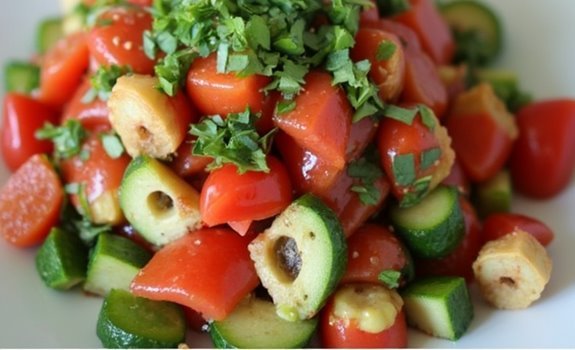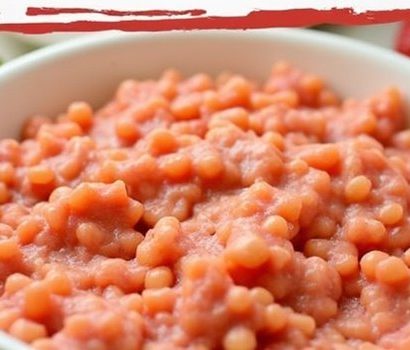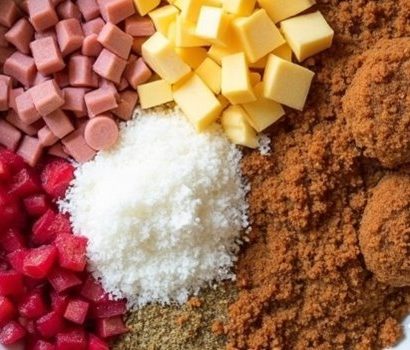Palestinian Salad
You might not know that Palestinian Salad, known as Salata Falahiyeh, is more than just a side dish; it’s a reflection of the region’s rich culture and history. This salad combines fresh ingredients like cucumbers, tomatoes, and herbs, offering a burst of Mediterranean flavors. If you’re curious about how to make this vibrant dish and its cultural significance, keep exploring to discover its delightful recipe and origins.
Why You’ll Love This Recipe
When you try this Palestinian salad, you’ll quickly discover why it’s a favorite for so many. Its vibrant flavors come from fresh herbs, lemon, and olive oil, making it invigorating and light.
With ingredients like cucumbers, tomatoes, and green onions, you’ll enjoy a delightful mix of textures. This salad isn’t only versatile but can be customized with tahini, sumac, or even Greek yogurt for extra flair. Additionally, its deep agricultural roots reflect the rich cultural heritage of Palestine, making it a meaningful dish to enjoy.
It’s easy to prepare, taking only about 10 minutes, so you can whip it up quickly as a side dish or appetizer. Plus, with low calories and rich nutritional benefits, including fiber and vitamins, this salad supports your health while connecting you to traditional Palestinian cuisine.
History
Palestinian salad, often called Salata Falahiyeh, has a rich history that reflects the diverse influences of the region. Known as “farmers salad,” it became popular when tomatoes entered Palestine a couple of hundred years ago.
Historical trade routes allowed for the exchange of ingredients like cucumbers, which came from India, and tomatoes, native to South America. This salad has deep roots in Palestinian cuisine and showcases the Ottoman Empire’s influence on vegetable dishes. Cultural significance is highlighted by the fact that many Arabs refer to it as Palestinian salad, contrasting it with other regional salads.
While Jewish immigrants in the late 19th century adopted it, the salad remains distinctively Palestinian due to its use of fresh mint, finely diced onions, and tomatoes. Each region has its variations, but the essence of Salata Falahiyeh endures through time.
Recipe
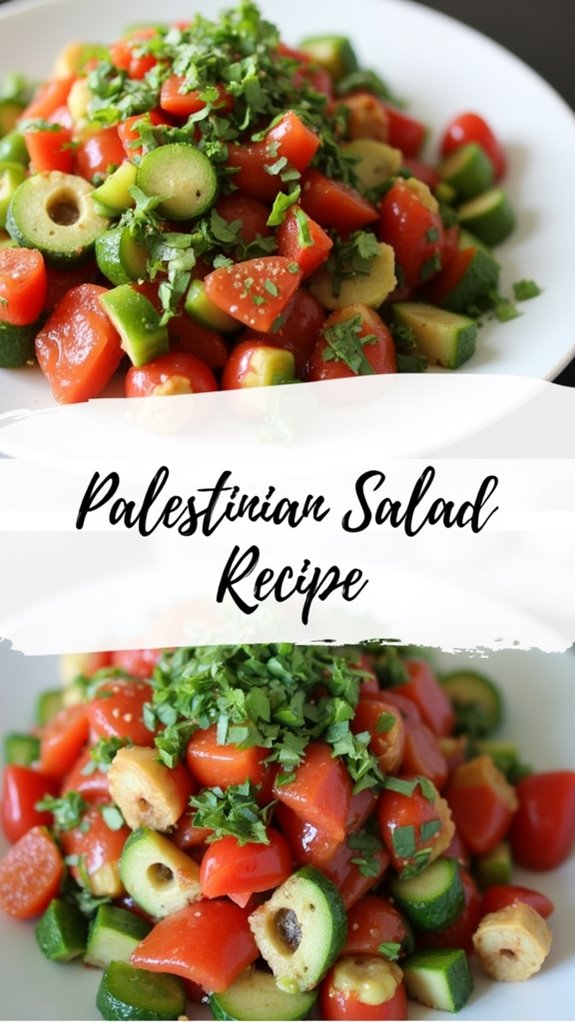
Palestinian Salad, also known as Fattoush or simply a fresh vegetable salad, is a vibrant dish that celebrates the rich flavors of Mediterranean ingredients. This invigorating salad is perfect for a hot day or as a side dish for a variety of meals. Its combination of finely diced cucumbers, tomatoes, and fresh herbs creates a delightful burst of flavor in every bite. The addition of lemon juice and olive oil brings brightness and richness, making it a staple in Palestinian cuisine.
What makes this salad even more appealing is its versatility. While the primary ingredients are simple, you can easily customize it with optional ingredients like radishes, olives, or even crispy pita bread for added texture. The freshness of the ingredients is key, so using ripe tomatoes and freshly chopped herbs will elevate the dish to another level.
Whether enjoyed as a light lunch or as a complement to grilled meats, Palestinian Salad is sure to please.
Ingredients:
– Cucumbers (finely diced)
– Tomatoes (finely diced, preferably Roma)
– Green onions/scallions (finely chopped)
– Fresh parsley (finely chopped)
– Fresh mint (finely chopped)
– Lemon juice
– Olive oil
– Salt
– Sumac (optional)
– Onions or shallots (optional, finely chopped)
– Radishes (thinly sliced, optional)
– Romaine lettuce (optional, for fattoush)
– Olives (optional, for fattoush)
– Pita bread (optional, for fattoush)
Instructions:
1. Begin by preparing the vegetables. Finely dice the cucumbers and tomatoes, making sure to remove the seeds from the tomatoes for a better texture. Chop the green onions, parsley, and mint very finely to release their flavors.
2. If using, finely chop onions or shallots and thinly slice radishes. Combine all the chopped vegetables and herbs in a large mixing bowl.
3. In a small bowl, whisk together lemon juice, olive oil, salt, and sumac (if using) to create a dressing. Adjust the seasoning to taste.
4. Pour the dressing over the salad mixture and toss gently to make sure everything is evenly coated.
5. Serve the salad immediately to maintain its freshness. If desired, add crispy pita bread or olives on top for a more substantial dish.
For the best results when making Palestinian Salad, always use the freshest ingredients available. Ripe tomatoes and vibrant herbs will enhance the flavor considerably. If you wish to add a bit more substance to the salad, consider incorporating cooked grains like maftoul or quinoa.
Final Thoughts
Exploring the flavors and history of Palestinian Salad opens up a window into not just a dish, but a rich cultural heritage. This salad reflects centuries of tradition, showcasing the connection between food and identity. Understanding its origins helps you appreciate the culinary influences that have shaped it over time. While often misattributed as “Israeli salad,” acknowledging its Palestinian roots is vital for preserving cultural heritage. Additionally, this dish serves as a form of resistance against cultural appropriation, emphasizing the importance of recognizing and respecting its history. As you enjoy Palestinian Salad, remember its seasonal significance and the ongoing innovation within Palestinian cuisine, which keeps this beloved dish alive for future generations. Influencer engagement significantly boosted the visibility of similar cultural dishes, highlighting the power of shared culinary traditions.
FAQ
When it comes to making Palestinian Salad, you might’ve some questions about ingredients, preparation, or serving suggestions. The core ingredients usually include tomatoes, cucumbers, green onions, parsley, and mint. You can add dill or chili peppers for extra flavor, depending on your preference. For dressing, mix lemon juice, olive oil, and salt. Chop the ingredients finely for a uniform texture, and let the salad marinate for 15-30 minutes to enhance the flavors. Additionally, consider incorporating spicy Gaza salad to add an exciting kick to your dish.
Palestinian salads can be served as side dishes, appetizers, or even a main meal with pita bread. If you have leftovers, store them in the fridge for 4-5 days. Feel free to adjust ingredients based on local influences or personal taste!
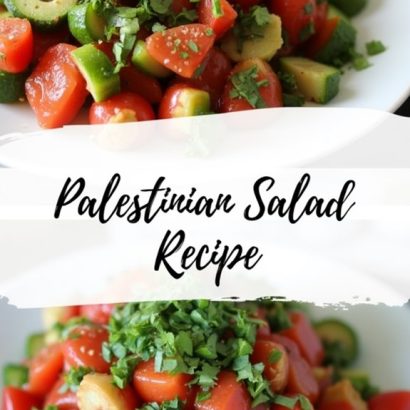
PALESTINIAN SALAD
Ingredients
- Ingredients:
- - Cucumbers finely diced
- - Tomatoes finely diced, preferably Roma
- - Green onions/scallions finely chopped
- - Fresh parsley finely chopped
- - Fresh mint finely chopped
- - Lemon juice
- - Olive oil
- - Salt
- - Sumac optional
- - Onions or shallots optional, finely chopped
- - Radishes thinly sliced, optional
- - Romaine lettuce optional, for fattoush
- - Olives optional, for fattoush
- - Pita bread optional, for fattoush
Instructions
- Instructions:
- Begin by preparing the vegetables. Finely dice the cucumbers and tomatoes, making sure to remove the seeds from the tomatoes for a better texture. Chop the green onions, parsley, and mint very finely to release their flavors.
- If using, finely chop onions or shallots and thinly slice radishes. Combine all the chopped vegetables and herbs in a large mixing bowl.
- In a small bowl, whisk together lemon juice, olive oil, salt, and sumac (if using) to create a dressing. Adjust the seasoning to taste.
- Pour the dressing over the salad mixture and toss gently to make sure everything is evenly coated.
- Serve the salad immediately to maintain its freshness. If desired, add crispy pita bread or olives on top for a more substantial dish.
- For the best results when making Palestinian Salad, always use the freshest ingredients available. Ripe tomatoes and vibrant herbs will enhance the flavor considerably. If you wish to add a bit more substance to the salad, consider incorporating cooked grains like maftoul or quinoa.

